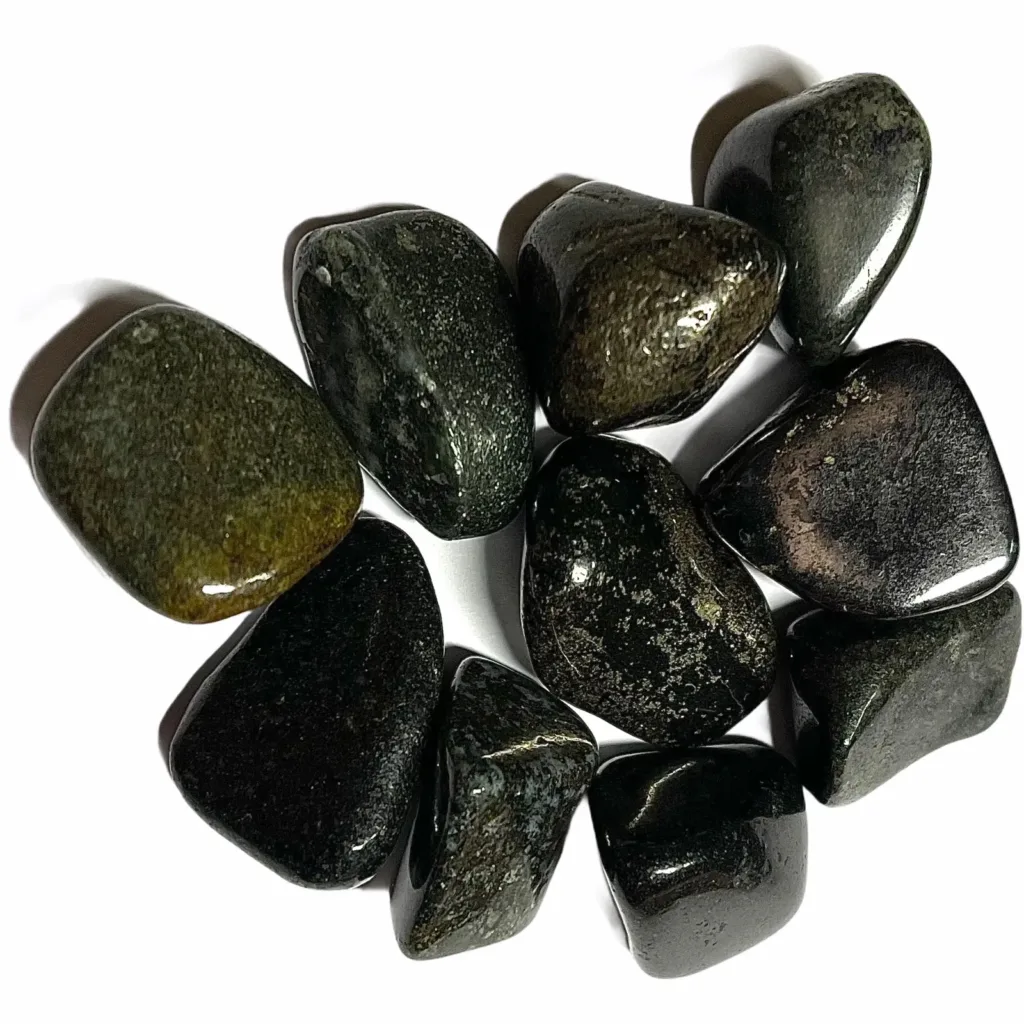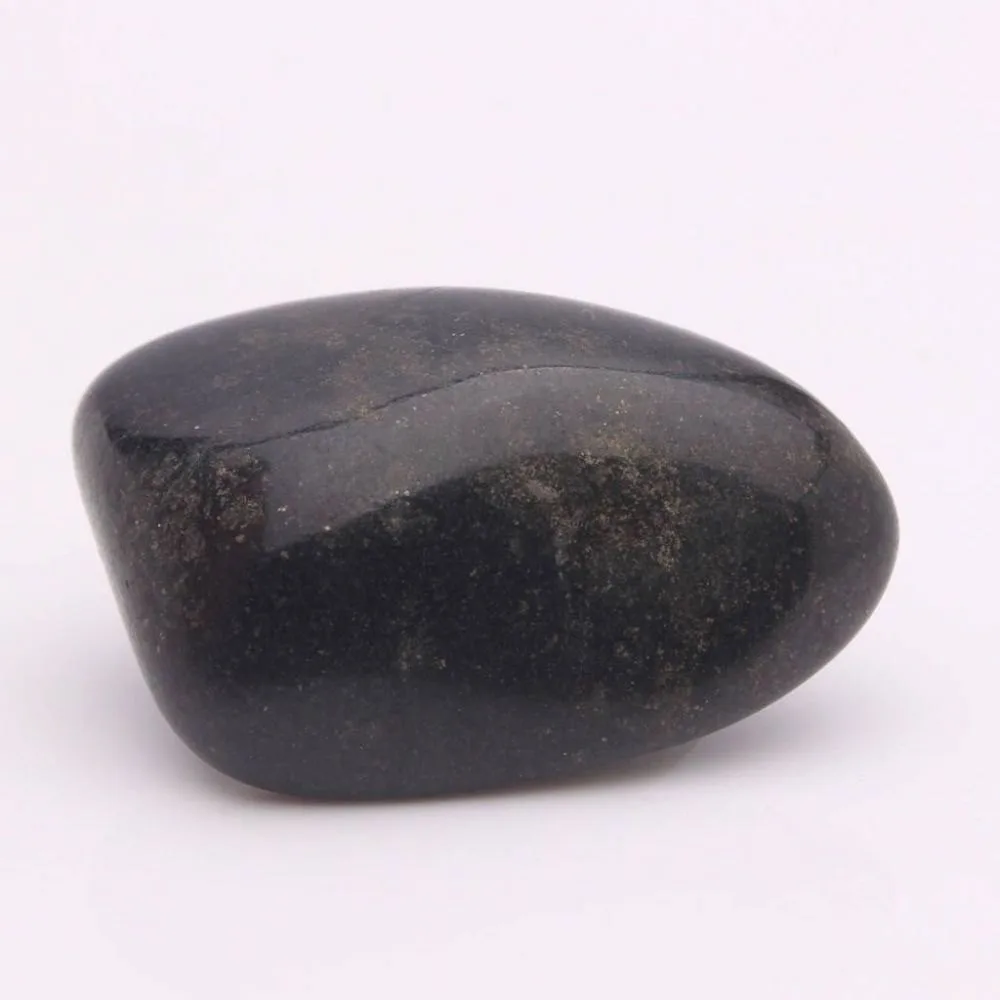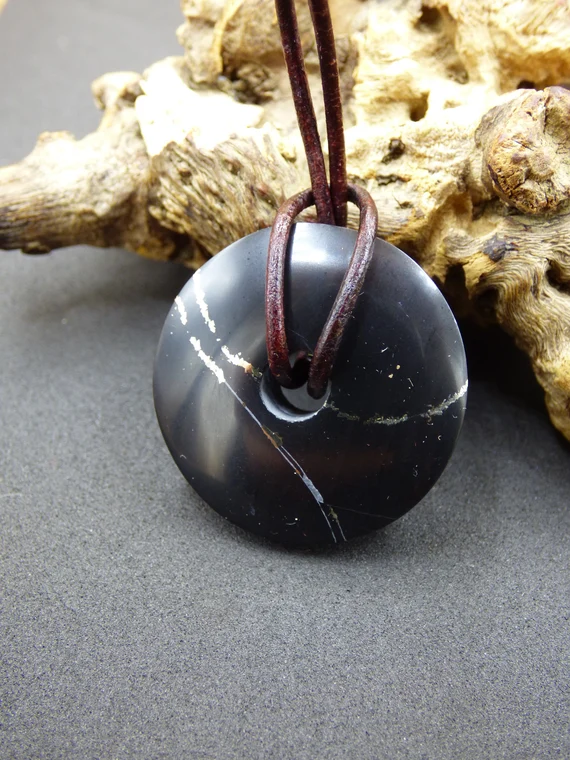Lemurian Jade is a type of jade that is known for its unique green coloration and distinctive patterns. It is named after the mythical lost land of Lemuria, which is believed by some to have existed in the Pacific Ocean. This jade variety is highly prized for its beauty and metaphysical properties.

Overview: Lemurian Jade is a variety of nephrite jade, which is one of the two main types of jade, the other being jadeite. It is primarily composed of calcium, magnesium, and iron, along with other trace minerals, which contribute to its green coloration. What sets Lemurian Jade apart is its particular shade of green, which can range from light, almost translucent greens to deeper, more vibrant hues. It often exhibits intricate patterns and swirls that add to its visual appeal.
Brief History and Origins: The origins of Lemurian Jade are shrouded in myth and legend. The name itself is inspired by the mythical lost continent of Lemuria, which some believe was a highly advanced civilization that existed in the Pacific thousands of years ago. According to lore, Lemurian Jade is said to have been discovered in the remote regions of the Himalayas, where it was believed to have been carried by glaciers from its original location.
In reality, the exact origins of Lemurian Jade are not definitively known. However, it is primarily sourced from regions known for their jade deposits, such as China, Myanmar, Russia, and Canada. The stone has been treasured for centuries by various cultures for its beauty and perceived metaphysical properties. In traditional Chinese culture, jade is highly revered and associated with luck, prosperity, and longevity. Similarly, indigenous cultures in other parts of the world have valued jade for its spiritual significance and healing properties.
Today, Lemurian Jade continues to be prized by collectors, artisans, and spiritual practitioners alike. It is often used in jewelry making, sculpture, and as decorative objects. Additionally, many believe that Lemurian Jade possesses metaphysical properties that promote emotional balance, harmony, and spiritual growth. Whether one is drawn to it for its aesthetic appeal or its purported energetic properties, Lemurian Jade remains a fascinating and cherished gemstone in the world of minerals and gemology.
Physical characteristics

Lemurian Jade, like other varieties of nephrite jade, possesses several distinct physical characteristics:
- Color: Lemurian Jade typically exhibits a vibrant green coloration, ranging from pale, almost translucent greens to deeper, richer hues. The color can be uniform or variegated, with swirls, streaks, or mottling of different shades of green.
- Translucency: Depending on the quality and composition of the stone, Lemurian Jade may vary in translucency. Some pieces may be nearly opaque, while others may display varying degrees of translucency, allowing light to pass through them to varying extents.
- Texture: Lemurian Jade has a smooth, often waxy texture when polished. However, in its raw or unpolished form, it may have a rougher texture due to the presence of mineral impurities or natural weathering.
- Hardness: Like all varieties of jade, Lemurian Jade is relatively hard and durable. It ranks between 6 and 7 on the Mohs scale of mineral hardness, making it suitable for use in jewelry, carvings, and other ornamental objects. However, its hardness can vary slightly depending on its specific composition and structure.
- Density: Lemurian Jade has a relatively high density due to its mineral composition, which includes calcium, magnesium, and iron. This density contributes to its weightiness and gives it a solid feel when held.
- Patterns and Inclusions: One of the distinguishing features of Lemurian Jade is its intricate patterns and swirls, which can vary widely from piece to piece. These patterns are often formed by mineral impurities or structural irregularities within the stone. Inclusions such as veins, spots, or other minerals may also be present, adding to the stone’s unique character.
Overall, Lemurian Jade possesses a combination of visual appeal, durability, and unique patterns that make it highly sought after by collectors, artisans, and enthusiasts alike.
Origins and Geological Formation of Lemurian Jade

The origins and geological formation of Lemurian Jade are complex and not fully understood, but they are closely tied to the broader geological processes that form jade deposits worldwide. Here’s an overview:
- Jade Formation: Jade, including Lemurian Jade, typically forms in metamorphic environments where high pressure and temperature conditions alter pre-existing rocks. Nephrite jade, the variety of jade to which Lemurian Jade belongs, forms from the metamorphism of serpentine, a hydrated magnesium-rich silicate mineral.
- Geological Settings: The specific geological settings where Lemurian Jade forms can vary, but it is often associated with regions of mountain building and tectonic activity. These areas experience intense pressure and heat, which are necessary for the metamorphic processes that create jade.
- Transport and Deposition: Once formed, jade deposits may be transported by geological processes such as erosion, glaciation, or tectonic movements. For example, in the case of Lemurian Jade, some believe that glaciers transported jade-bearing rocks from their original formation sites to other regions, such as the Himalayas.
- Secondary Processes: After deposition, jade deposits may undergo secondary processes such as weathering, erosion, and chemical alteration. These processes can affect the appearance and composition of the jade, giving rise to variations in color, texture, and mineral content.
- Mining and Extraction: In modern times, Lemurian Jade is typically mined from jade-bearing deposits using various mining techniques. These deposits may be located in remote mountainous regions or alluvial deposits, where jade-bearing rocks have been weathered and transported by rivers or glaciers.
- Artisanal Work: After extraction, Lemurian Jade is often carved, polished, and fashioned into various objects such as jewelry, sculptures, and decorative items. Skilled artisans use traditional techniques to highlight the stone’s natural beauty and enhance its aesthetic appeal.
While the specific origins and geological history of Lemurian Jade may vary depending on the region and deposit, its formation is intricately linked to geological processes that have shaped the Earth’s crust over millions of years. The allure of Lemurian Jade lies not only in its physical beauty but also in the geological forces that have shaped it into a precious and sought-after gemstone.
Locations of Lemurian Jade Deposits

Lemurian Jade deposits are not as widely documented or recognized as those of other jade varieties. The term “Lemurian Jade” itself is more commonly associated with metaphysical and mystical beliefs rather than specific geological locations. However, some regions known for producing nephrite jade, which Lemurian Jade is a type of, may also yield specimens that fit the characteristics attributed to Lemurian Jade. Here are some regions where nephrite jade is traditionally mined, which could potentially include Lemurian Jade:
- China: China has a long history of jade mining and is one of the world’s largest producers of nephrite jade. The Xinjiang region, in particular, is known for its nephrite deposits, including those in the Kunlun Mountains and the Hotan (Hetian) area. It’s possible that some specimens referred to as Lemurian Jade could originate from Chinese deposits.
- Russia: Russia is another significant producer of nephrite jade. The Sayan Mountains in Siberia and the Khabarovsk region in the Russian Far East are known for their nephrite deposits. These areas have been mined for centuries, and some specimens with Lemurian Jade-like characteristics may have originated from these deposits.
- Canada: Canada, specifically British Columbia, is known for its nephrite jade deposits. The Cassiar Mountains and the Jade City area are notable for their jade mining activities. While Canadian nephrite jade tends to be highly valued for its quality and color, it’s possible that some specimens from these regions could fit the description of Lemurian Jade.
- New Zealand: New Zealand has significant nephrite jade deposits, particularly in the South Island. The West Coast region, including areas such as Hokitika and the Arahura River, is known for its jade mining. While New Zealand nephrite jade is typically known as “Pounamu” or “Greenstone,” some specimens may exhibit characteristics associated with Lemurian Jade.
It’s important to note that the term “Lemurian Jade” is not widely recognized in the geological or gemological communities, and its use is often more associated with metaphysical beliefs rather than scientific classification. As such, specific deposits labeled as Lemurian Jade may not have been officially identified or documented. However, regions with significant nephrite jade mining activities, such as those mentioned above, could potentially yield specimens that align with the characteristics attributed to Lemurian Jade.
Lemurian Jade Cultural Significance, Uses and Modern Applications

While Lemurian Jade itself may not have a long-established cultural significance like traditional nephrite jade, it holds importance in various contemporary contexts, particularly in metaphysical and holistic practices. Here’s an overview of its cultural significance, uses, and modern applications:
- Metaphysical and Spiritual Beliefs: Lemurian Jade is often associated with spiritual and metaphysical beliefs, drawing upon the mythical Lemurian civilization for inspiration. Some believe that Lemurian Jade carries the energy of this ancient civilization and promotes spiritual growth, healing, and connection with higher consciousness. It is thought to resonate with the heart chakra, encouraging emotional balance, compassion, and harmony.
- Healing Practices: In holistic healing practices, Lemurian Jade is used for its purported healing properties. It is believed to promote physical well-being by supporting the body’s natural healing processes and relieving stress, anxiety, and emotional blockages. Some practitioners use Lemurian Jade in crystal healing layouts or as meditation aids to enhance relaxation and inner peace.
- Jewelry and Ornamental Uses: Like other varieties of jade, Lemurian Jade is often crafted into jewelry pieces such as necklaces, pendants, bracelets, and earrings. Its vibrant green color and unique patterns make it an attractive choice for adornment. Beyond jewelry, Lemurian Jade may also be used in ornamental objects such as figurines, carvings, and decorative items for its aesthetic appeal.
- Home Décor and Feng Shui: In Feng Shui practices, jade is highly valued for its auspicious energy and protective qualities. Lemurian Jade may be incorporated into home décor items such as statues, bowls, or ornaments to attract positive energy, prosperity, and harmony into living spaces. It is often placed in areas associated with abundance, such as the wealth corner of a room.
- Collecting and Investment: Collectors with an interest in crystals and gemstones may seek out Lemurian Jade specimens for their rarity, beauty, and perceived energetic properties. While its value is subjective and may vary depending on factors such as quality, size, and craftsmanship, well-preserved Lemurian Jade pieces may appreciate in value over time, making them a potential investment for collectors.
- Artistic and Creative Expression: Artists and craftsmen may use Lemurian Jade as a medium for creative expression. Its unique colors, patterns, and textures offer endless possibilities for sculpting, carving, and other artistic endeavors. Whether used in traditional jade carvings or contemporary mixed-media artworks, Lemurian Jade can inspire creativity and imagination.
Overall, while Lemurian Jade may not have ancient cultural traditions associated with it, its modern significance lies in its role as a symbol of spiritual connection, healing, and aesthetic beauty. Whether used in personal practices, decorative arts, or as a collectible item, Lemurian Jade continues to captivate individuals with its mystical allure and intrinsic value.




































